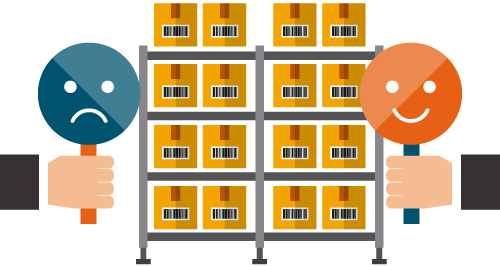The Link Between Accurate Inventory Levels and Customer Satisfaction
Built For


Accurate Inventory Levels and Customer Satisfaction
When you think of what keeps customers happy, factors like quality products, timely deliveries, and responsive service may come to mind. But did you know that accurate inventory levels are critical in ensuring customer satisfaction?
In today’s on-demand economy, customers expect instant information about product availability. When your inventory levels are off, it can disrupt the entire shopping experience, potentially leading to lost sales, frustrated customers, and negative reviews.
In this article, we’ll explore how accurate inventory management affects customer satisfaction and how you can improve your inventory tracking to keep your customers coming back for more.
Why Inventory Accuracy Matters for Customer Satisfaction
When inventory levels are precise, businesses can provide customers with a reliable shopping experience. Whether you’re selling products online or via a direct sales team, inventory accuracy ensures that customers know what is in stock, what’s available for immediate shipment, and when they can expect to receive their items.
- Enhancing Transparency: Customers appreciate transparency. Showing real-time inventory levels helps set expectations and reduces uncertainty during the shopping process.
- Avoiding Stockouts: One of the most common ways to disappoint a customer is to tell them something is available when it’s not. Notifying customers of an out-of-stock situation after they place an order is a surefire way to damage trust.
- Fulfilling Orders on Time: Accurate inventory allows for efficient order fulfillment, ensuring customers get their purchases without delay. Late deliveries, especially when caused by errors in inventory tracking, can lead to frustration.
Common Challenges That Lead to Inventory Inaccuracies

Unfortunately, maintaining accurate inventory levels is easier said than done. Many businesses struggle with inconsistencies in their inventory data, which can lead to customer dissatisfaction. Here are a few common challenges:
- Lack of Synchronization Across Sales Channels: If you sell products via multiple channels (eCommerce websites, online marketplaces, EDI, the direct sales team), your inventory levels must be synced across all channels. Otherwise, you risk selling the same item to multiple customers, resulting in backorders and unhappy buyers.
- Manual Data Entry Errors: Relying on manual processes to track inventory is prone to mistakes. Something as simple as a misplaced number or an incomplete entry can throw off your entire stock count.
- Poor Stock Visibility: Without real-time visibility into stock levels, businesses can oversell products or fail to restock items on time, leading to stockouts and delays.
The Role of Inventory Management Software
The key to maintaining accurate inventory levels—and keeping your customers happy—lies in automating the process. Inventory management software helps you overcome the challenges mentioned above by providing real-time stock visibility and automation tools to ensure your inventory is always up to date.
Inventory software can enhance accuracy and customer satisfaction with:
- Automated Stock Updates: Whenever an item is sold, received, or transferred, the software automatically updates inventory counts in real time. This eliminates the risk of human error and ensures that customers always see the correct product availability.
- Cross-Channel Synchronization: With centralized data, your inventory levels are updated across all your sales channels. This prevents overselling and ensures that stockouts are communicated to customers promptly.
- Forecasting Tools: Inventory software can help predict demand and prevent stockouts or overstocking using historical data and trends. This means you can always meet customer demand without holding too much inventory, which ties up cash.
Impact of Accurate Inventory Levels on Customer Trust

Trust is a critical component of customer satisfaction, and nothing breaks trust faster than a poor shopping experience due to inaccurate inventory. When customers know they can count on your business to have products available as advertised, it boosts their confidence and encourages repeat business.
- Order Fulfillment Confidence: Customers who have a positive experience with accurate inventory and fast fulfillment are more likely to return. Whether it’s a first-time buyer or a loyal customer, they’ll trust that your business can deliver on its promises.
- Fewer Complaints and Returns: Inaccurate inventory can lead to shipping wrong or substitute items, which creates more complaints and returns. With real-time stock tracking, you minimize these errors, ensuring customers receive precisely what they ordered.
Best Practices for Improving Inventory Accuracy
Maintaining inventory accuracy is a continuous process, but you can significantly reduce errors and keep customers satisfied by following best practices.
- Implement Barcode Scanning: Barcoding technology reduces human error by automating stock movement tracking. It speeds up inventory counting and ensures that every item is accounted for.
- Use Cycle Counting: Instead of performing a full inventory count once a year, use cycle counting to audit smaller portions of your inventory throughout the year. This helps you catch discrepancies sooner and keep your inventory levels accurate.
- Automate Reorder Alerts: Inventory management software allows you to set reorder points to receive alerts when stock is running low. This ensures you can replenish products before they run out, preventing stockouts.
- Train Your Staff: Even with the best technology, human error can still occur. Make sure your staff is trained to use inventory management systems and follow proper procedures for receiving and recording stock.
Accurate Inventory Levels Drive Customer Loyalty
Accurate inventory levels don’t just improve operational efficiency—they directly impact customer satisfaction. When customers can rely on your business for timely deliveries and transparent product availability, they’re more likely to become repeat buyers and advocate for your brand.
Investing in inventory management software gives you the tools to automate stock tracking, improve accuracy, and ultimately boost customer satisfaction. If you’re looking for a way to keep your customers happy and returning for more, start by ensuring your inventory levels are spot on.
Call us at 817-870-1311





